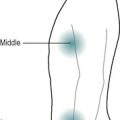35. The use of moxibustion
Chapter contents
Moxa273
Deciding whether to use moxa273
Moxa cones and sticks275
Contraindications276
Moxa
What is moxa?
Moxa is a downy material prepared from the leaves of the herb Artemesia vulgaris latiflora. This is similar to the common mugwort plant that is grown in the UK and USA. To prepare the artemesia, the veins of the leaves are stripped, then ground, aired and dried before it becomes what is commonly called moxa ‘punk’ or ‘wool’.
When is moxa used?
An acupuncturist uses moxa during a treatment in order to warm a patient. Whether to use moxa or not is an important issue. In some cases it can be essential in order for patients to make progress. For example, patients who are cold will not improve, or will take much longer to get better, if they do not have moxa. On the other hand, it can be dangerous to heat a patient who is already too hot.
How is moxa used?
Most commonly a Five Element Constitutional Acupuncturist rolls the moxa into small cones that are then placed on the acupuncture points and lit. Sometimes a moxa stick is used instead of cones, especially if a large area needs to be warmed. Moxa cones can be used alone and have a stimulating effect on a patient’s qi. More often they are used before the needles are inserted and in this case they warm a point and the needles take the heat to the point.
Deciding whether to use moxa
As a result of the diagnosis, the practitioner should be able to decide whether to use moxa. The patient will fall into one of three categories:
• The patient definitely needs moxa and is unlikely to get better or will not get better as quickly without it.
• Moxa may be used to tonify the patient but is not essential. In this case the patient may not be abnormally cold, but the warmth will prepare the point before a needle is inserted.
• Moxa should definitely not be used. It will not help and it may make the patient worse.
A patient may change categories as treatment progresses, and this should be noted during the ongoing process of diagnosis.
Moxa is used more frequently in cold weather and during the winter, or when there is a cold and damp climate.
Keys to deciding if moxa is appropriate
Touch, visual observation, questioning and smelling give the practitioner the relevant information needed in order to decide whether moxa will be of benefit. 1
1The concept of yin and yang is useful here. Yang energy is warming and moving. Yin energy is nourishing and cooling. Yang deficiency requires the use of moxa, Yin deficiency may or may not require moxa and Full Heat definitely indicates that moxa is forbidden. For these distinctions, see a good TCM textbook, such as Maciocia, 2005.
Touch
When palpating the patient during the physical examination, the practitioner may notice that certain areas of the body are cold. For example, one or more of the three jiao may be cold. This indicates that moxa might be beneficial when treating the Organs situated in the cold jiao. Additionally, if the patient’s feet, hands, legs and arms or lower back are cold to the touch, there is also a case for using moxa.
If a patient’s pulse is particularly slow, for example 60 beats per minute, this may indicate a need for warming the qi. Some exceptions to this are if the patient is undergoing strenuous physical training or is taking medications such as beta-blockers, both of which cause the pulse to slow.
Observation
A very pale face (pale and bright even more so) suggests the patient is cold and would benefit from moxa. There may be more obvious signs such as a person wearing a jumper when others are in T-shirts or the person huddling close to heaters and shivering.
Questions
It is important for the practitioner to question several areas when deciding if the patient needs moxa:
• Does the patient feel cold?
• Is one or more parts of the body cold or hot?
• Does the patient notice any difference between their own and others’ temperature? For example, do they wear thermal underwear even in the summer, or always turn the central heating down while others want it turned up?
• Does the patient have symptoms that are better for cold or heat?
• Does the patient prefer one season to another and is this to do with the temperature?
• Does the patient like hot or cold drinks or hot or cold food? For example, preferring drinks that come straight from the refrigerator suggests that the patient is hot and the practitioner should take care with moxa.
• Does the patient have a bitter taste in the mouth? This can be an indication of heat.
• Is there any area of the body where there is inflammation?
Indications that the patient is dry can also be relevant because moxa is drying as well as warming. Care should be taken if moxa is used on a patient who is frequently thirsty and has dry skin and hair as it could possibly increase the symptoms of dryness.
Smelling
Strong odours tend to indicate heat. For example, a strongly smelling vaginal discharge, diarrhoea which has a strong odour or urine which is yellow and strong smelling all indicate that there is some excess heat. These may be local as opposed to systemic indications and should be recognised as such when integrating all the other indications for using moxa or not.
Integration of information
Many patients are straightforward and it is easy for the practitioner to discern whether they tend towards being cold, hot or more or less in the middle. Thus they place themselves in one of the categories suggested above.
Contradictions, where some observations indicate cold and some indicate heat, are more difficult to resolve. Even if patients have some signs of cold, but several of their major indicators point to heat, the practitioner would be advised to avoid moxa. Using moxa when a person is already hot can be damaging. Thus, if in doubt, the practitioner should avoid using moxa. 2
Testing using moxa
When a patient has a mixture of cold and heat signs, the practitioner may be in doubt as to whether to use moxa or not. In this case, the practitioner can select an appropriate point and use one moxa cone on it and then check whether the pulses feel any better or any worse. If the pulses feel slightly better, then the practitioner can use a few more moxa cones, continuing to check for improvement. After the minimum number of moxa cones have been used the practitioner should wait for the patient’s feedback at the next treatment in order to decide whether using moxa is suitable or not.
If the pulses tighten or feel less harmonious as a result of treatment, no further moxa should be used and the conclusion drawn would be that moxa is not appropriate.
Moxa cones and sticks
Making moxa cones
Grades of moxa may be rough, intermediate or fine. The intermediate grade is most commonly used for making moxa cones. The rougher moxa is often too coarse to roll into cones. Some practitioners prefer to use the fine-grade moxa but this is thought by others to burn too rapidly. The fine moxa is often used by Japanese acupuncturists.
To make a moxa cone a small amount of moxa punk is rolled between the thumb, index and middle fingers until it becomes a cone shape. This is slightly larger than a grain of wheat – about 0.75cm in height and 0.5cm in diameter. At first the practitioner may prefer to prepare all of the cones before starting to use moxa on the patient. In time she or he will become adept at creating the cones more rapidly and is then able to make them while the moxa treatment is in progress.
Using moxa cones
The use of moxa cones is called direct moxa as the cone is placed directly on the skin (Figure 35.1).
 |
| Figure 35.1 • |
• The cone is placed on the acupuncture point then lit with an incense stick.
• As the cones burn down the patient feels a warm sensation on the points as heat is generated directly to the qi in the channels.
• The moxa cone is removed when the patient indicates that it feels hot. The practitioner removes the moxa with the thumb and little finger (the fingers not used for pulse taking) or with tweezers.
• The left side is treated first, followed by the right.
• Usually three to seven moxa cones are applied to each point, depending on which point is used. Some points can take more moxa cones than others, for example up to 100 cones can be used on Bl 43, although this is unusual. (For suggested numbers of moxa per point, see the chapters on the different points in Section 6, this volume.)
Before applying moxa for the first time, it is vital that the patient understands what the practitioner is about to do and knows the importance of saying when the moxa cone is hot. If a cone is left on for too long this could burn the patient and cause scarring.
If moxa is used on the umbilicus (Ren 8) it is placed on a bed of salt to protect this sensitive area. Moxa can also be placed on ginger; in this case it is more warming as well as providing protection for the skin.
Moxa sticks
Five Element practitioners use moxa sticks less frequently than moxa cones, although they may use one to warm a large area, for example, the lower abdomen after childbirth. A moxa stick can be:
• held in one place for 5–10 minutes
• moved in a circular motion to spread heat and cover a large area
• pecked at a point without touching the skin – this is used for quick stimulation of a point
Contraindications
Moxa is contraindicated when there are signs of heat. In this case a patient may:
• feel hot
• like the cold
• be hot to touch
• have red, hot skin
• have a florid appearance
• have hot flushes
• have a fever
• have high blood pressure, if caused by heat
In addition, moxa should not be used on the following areas:
• the face or sensitive areas
• on the lower back or abdomen of pregnant women
• on large blood vessels
Summary
1 Moxa is prepared from the herb Artemesia vulgaris latiflora.
2 It is used during a treatment to warm a patient and in some cases can be important in order for a patient to progress.
3 It is most often used as small cones or in the form of a moxa stick.
4 It is important to use moxa when a patient is cold. Sometimes it is not essential to use moxa but it will help to tonify a patient. Moxa is contraindicated if a patient is already hot.
5 Touch, observation, questioning and smelling inform the practitioner as to whether moxa will be beneficial.





